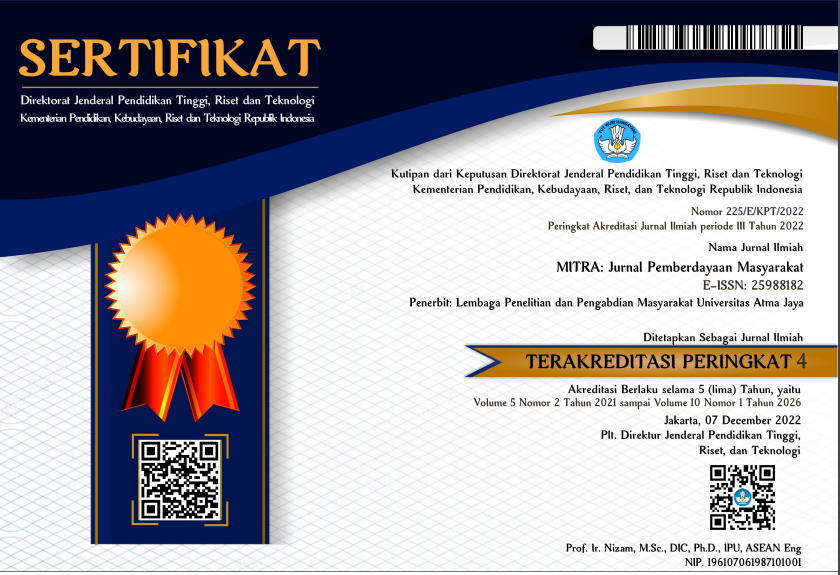The Application of Processing Technology for Jelly Candy Made with Lat Sea Grapes in Southeast Maluku Regency
DOI:
https://doi.org/10.25170/mitra.v5i2.2597Kata Kunci:
seagrapes, Caulerpa, jelly candy, science and technologyAbstrak
Seagrapes (Caulerpa sp) thrive in the waters of the Kei Islands of Maluku and can be found throughout the year. However, they are hitherto only used as fresh vegetables. It turns out that sea grapes can be processed into various food and non-food products. The results of a field survey in Ohoi Village, Southeast Maluku, reveal that the community only uses lat as a vegetable and has not used lat as a processed food product. One reason is that the people in Ohoi Village are not aware of its health benefits. This indicates that lat in Ohoi Village has not been used optimally as a raw
material for the food and beverage industry despite its high nutritional and economic value. It will be beneficial for the coastal women's group in Ohoi Village to receive training on processing and producing lat-based food items. They can increase their knowledge and skills, thereby improving the welfare of coastal communities and their families. This community service aims to take advantage of the potential of lat sea grapes in Ohoi Village, Southeast Maluku, through the application of lat-based jelly candy processing technology, encouraging the coastal women in Southeast Maluku to become lat-based jelly candy entrepreneurs and resultantly increasing their productivity in the long run.
Referensi
Rieuwpassa, F, & Tapotubun, A. M. (2017). Memuliakan laut: Pencitraan produk ikan olahan tradisional sebagai identitas daerah Maluku. Book chapter. 1st ed. Indonesia. Pattimura University Press.
Rieuwpassa, F, & Tapotubun, A. M. (2020). Teknologi pengolahan ikan tanpa limbah: Strategi peningkatan pendapatan masyarakat nelayan dan menjamin M-LIN berkelanjutan. In Latumahina, F. and Haumahu, J. P. (eds). Book chapter Kapita selekta: Pengelolaan sumber daya kemaritiman dan kelautan seri I. Ambon: Pattimura University Press, 19–38.
Tapotubun, A. M. (2018). Komposisi kimia rumput laut (Caulerpa lentillifera) dari perairan Kei Maluku dengan metode pengeringan berbeda. Jurnal Pengolahan Hasil Perikanan Indonesia, 21(1), 13–23.
Tapotubun, A. M, Matrutty, Th.E.A.A, Tapotubun, E.J, Mailoa, M.N, & Fransina, E.G. (2018). The sensory characteristic of Caulerpa jelly candy based on the consumers acceptance. Journal Science Nature, 1(1), 015–021.
Tapotubun, A. M. Rieuwpassa, F., Supratman, U., & Setha B. (2019). Effect of different drying methods on phytochemical content of Caulerpa lentillifera from Kei islands.Journal of ChemTech Research, 12(6), 109–115.
Tapotubun, A. M., Matrutty, Th.E.A.A, Riry, J., Tapotubun, E.J, Fransina, E.G, Mailoa, M.N., Riry, W.A., Setha, B., & Rieuwpassa, F. (2020). Seaweed Caulerpa sp position as functional food. IOP Conference Series: Earth and Environmental Science. https://doi: 10.1088/1755-1315/517/1/012021.
Tapotubun, A. M. (2021). Pengolahan ikan dan promosi Maluku sebagai center of fish product. In Latumahina, F. (ed.) Maluku masa depan: Bunga rampai pemikirian para akademisi bidang sains dan teknologi Maluku. Book chapter I. Ambon: Penerbit Adab, 1–24.
Tapotubun, A. M, & Savitri, I. K. E. (2017). Growth inhibition of pathogenic bacteria on fresh fish by using dried seaweed Caulerpa lentillifera during storage. In Mahardika et al. (eds) Proceeding The International Conference on Marine Biodiversity “Advancing Scientific Tools and Capacity Building for Conservation and Sustainable Use of Marine Biodiversity". Udayana University Press, 114–117.
Tapotubun, A. M, Savitri, I. K. E, & Matrutty, T. E. A. A. (2016). Penghambatan bakteri patogen pada ikan segar yang diaplikasi Caulerpa lentillifera. Jurnal Pengolahan Hasil Perikanan Indonesia, 19(3), 299–308.
Unduhan
Diterbitkan
Cara Mengutip
Terbitan
Bagian
Lisensi
This license allows reusers to distribute, remix, adapt, and build upon the material in any medium or format for noncommercial purposes only, and only so long as attribution is given to the creator. If you remix, adapt, or build upon the material, you must license the modified material under identical terms.







_.jpeg)




.png)
2.png)
.png)
.png)



